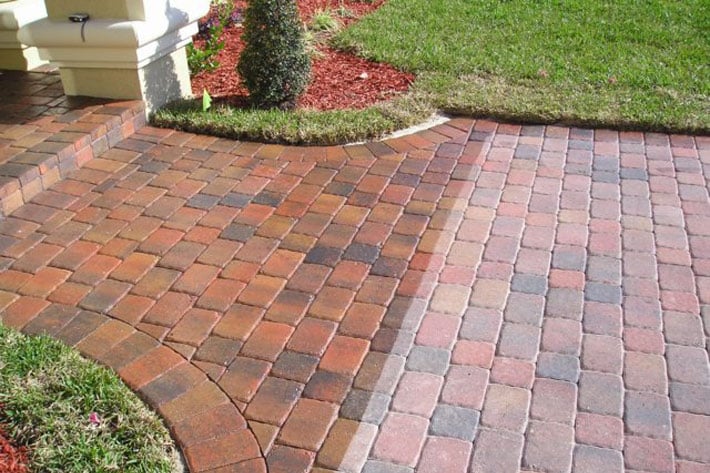Demand for new patio installations remains strong despite labor shortages. Concrete paver manufacturers in the United States and Canada said sales increased by 7.8% during 2020, according to the 2021 ICPI Contractor Business Report. In 2019 alone, nearly 1.71 million square feet were installed, based on ICPI statistics.
Even while you’re enjoying increasing numbers of new installations, you may be missing out on lucrative opportunities. Patios are fairly low maintenance and typically withstand fluctuating weather conditions when correctly installed.
Like anything left out in the elements, patios don’t stay looking like new forever—sealers wear off, joint sand deteriorates and settling occurs due to occasional base failure. Property owners are willing to pay for a refresh to get it looking like new again.
Over time, as projects age and these issues occur, offering a maintenance service to include repairs, cleaning, and resealing can help restore the aesthetics of the patio. Servicing patios is an underserved market that can provide big add-on revenue opportunities.
Selling Paver Restoration
There are plenty of ways to build a fall or spring patio renovation project. One approach is to introduce the concept during new installations. Include a service option that includes coming back to the site in two years for cleaning and repairs.
Service contracts are a little harder to sell because the customer sees the patio when everything looks pretty, and they think it will stay that way. Presenting it as an optional service at the time of the initial project can get customers thinking about it.
Reconnecting with clients who purchased patios two, three, four or five years ago is a lucrative source for leads. Calling to check in and talk about updating or cleaning their patio can land projects. The marketing and social media strategies you use to promote other new or existing services expand the potential—especially since few contractors offer patio restoration.
There are plenty of ways to bundle a fall package. Not every contractor likes sealing because there are times it can cause problems if it’s not done right. But you don’t necessarily need to offer sealing. Cleaning, repairing heaved or sunken sections, and filling in joints can make a dramatic improvement.
Is the Job Worth Your Time?
Pricing is job-specific, but successful contractors have indicated that project pricing can range from $1.50 to as high as $4 per square foot depending on the scope. In many cases, that may be only for a few hours of work. That lets you get in, get your money and move on.
Patio maintenance increase revenues and creates alternatives to paying idle crews or layoffs during the traditional “slow months.” Finding good employees is hard enough and selling patio restoration projects is a solid income stream in traditionally slower months.
Chances are you have the tools needed to get started. Generally speaking, a commercial-grade pressure washer is the primary tool for patio jobs. If you’re installing pavers, you also likely have a broom, blower and compactor for installing polymeric sand.
Minor Fixes Can Make Big Impacts
Whether it’s pulling up sunken pavers, fixing settling on the edges, or repairing around steps, e minor fixes can return the space to its original condition. Consider these:
- Pull any weeds and remove all debris with a commercial-grade pressure washer and cleaner. Thoroughly cleaning all the joints. Heated water provides the deepest clean possible;
- Add the jointing sand and compact as needed; and
- Apply a sealer to help stabilize joints in between service visits.
There are many sealer choices available, so it’s important to choose the right one for your job. Water-based sealers are generally thinner and easier to apply. Solvent-based sealers tend to be a little thicker depending on the desired finished look and less breathable, increasing the likelihood of moisture being trapped between the paver surface.
Customer preference is one consideration to keep in mind when choosing a sealer. Some prefer the “wet look” of just-rained-on pavers. Acrylic in the sealer determines how “wet” the finish looks. Sealers with more than 25% acrylic or polyurethane content create a semi-gloss finish, while a sealer that’s 30% solid or higher produces a high-gloss wet look.
There’s a wide range of customer preferences. Ewing carries a wide range of sealers so you can deliver a wet-look gloss, semi-gloss or natural matte finish.
Add-on services like patio maintenance can be a great way to use products left over from previous jobs. If you’re using sealer or cleaner stored in your shop for an extended time, check the expiration codes and avoid using expired products.
We Have You Covered
Adding restoration and resealing services to your business can boost your bottom line and make the most of the inventory and tools you already purchase. Use these tips and lean on your local Ewing team to launch a successful patio maintenance line of service.




